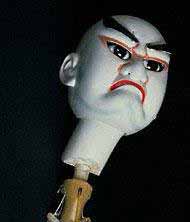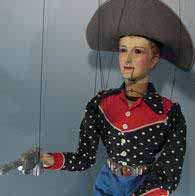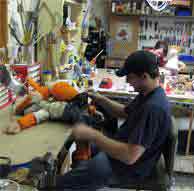The Center for Puppetry Arts in Atlanta, Georgia, is making sure the traditions stay alive and well.
VOICE ONE:
I'm Bob Doughty.
VOICE TWO:
And I'm Faith Lapidus with EXPLORATIONS in VOA Special English. Since ancient times, cultures around the world have been making and performing with puppets. They express the ideas and beliefs of human societies through stories. Puppets are lifeless objects that are controlled in such a way as to become lifelike. It is the role of the puppeteer to make these forms come alive.
Join us as we explore the world of puppetry and visit an organization in Atlanta, Georgia that works to support this special art form.
(MUSIC)
VOICE ONE:

In Japan, the tradition of bunraku puppetry dates back hundreds of years. A bunraku puppet is quite large. Unlike most puppets, it requires three puppeteers to control. One puppeteer controls the doll's head, face, and right hand. Another puppeteer controls the doll's left hand. And the third operates its legs and feet. The puppeteers train for many years to move as one in bringing the puppet to life to act in complex theater productions.
VOICE TWO:
In Turkey, the Karagoz tradition of shadow puppets began around the 17th century. These Turkish shadow puppets are flat. They are made of very thin pieces of leather that have been painted with bright colors. With shadow puppets, the puppeteer stands behind a white cloth surface and rests the slightly see-through puppets against the cloth. Light behind the cloth screen illuminates the colorful puppets for the people watching on the other side.
VOICE ONE:
The Punch and Judy tradition of puppet shows has its roots in the 16th century Italian Commedia dell'Arte theater. Punch and Judy shows later became very popular in Britain. Many other countries have their own versions of Punch and Judy puppets. The French equivalent to Punch is Polichinelle, while in Russia he goes by the name Petrushka.
VOICE TWO:
In addition to shadow puppets, there are three general puppet forms. Rod puppets are controlled by a stick or wire attached to the puppet's main body parts. As you can guess from the name, hand puppets are worn on and controlled by the puppeteer's hand. Marionettes are controlled from above by a series of strings or wires.
Before the age of television and the Internet puppet shows were a major form of entertainment for audiences of all ages all over the world. What kind of puppet traditions exist where you live?
(MUSIC)
VOICE ONE:
To learn more about the history of puppet traditions, you can visit the Center for Puppetry Arts in Atlanta, Georgia. The center's museum is filled with more than 1500 puppets from around the world. They tell about the rich history of this art.
Jeremy Underwood is the curator of the museum. He can tell stories about each puppet in the museum, including a finely carved marionette from Mexico.

JEREMY UNDERWOOD: "This is actually a really cool piece. It's done by the Rosete-Aranda Company. They were active in the twenties and thirties. They were doing biblical stories in the beginning, but then they branched out to these different folk stories. This is a cowboy. They were actually drawing influence from Italian puppetry which is this very realistic puppetry. So not all puppetry is just foam and fleece. It's very intricately carved pieces of art."
VOICE ONE:
Mr. Underwood says that Asia has a very rich tradition of puppetry. He says that about 800 of the puppets in the Center for Puppetry Arts collection are from Asia.
JEREMY UNDERWOOD: "In this case we have Wayang golek, Wayang klitik which are two major forms of traditional Indonesian puppetry, and behind you we have Wayan kulit which is the shadow puppetry of Indonesia. So these are three major forms of puppetry in Indonesia. And also in this case we have Chinese and Indian puppets."
VOICE TWO:
Of course, not all of the puppets at the Center for Puppetry Arts date back to ancient times. Many are very recent, including a collection of puppets created by the famous American puppeteer Jim Henson. He created puppets for several television series and movies including "Fraggle Rock," "The Muppets," and "Sesame Street." His shows were extremely popular because they were both funny and educational. You can see several of his characters including Big Bird and the Swedish Chef.
VOICE ONE:
One large puppet called Trashcan Phoenix was made by the artist Michael Curry. He has designed productions for performance groups including Cirque du Soleil, the Metropolitan Opera in New York City, and Disney Theatrical Productions.
(SOUND)
At the press of a button, a form that looks like a trashcan unfolds and spreads its wings to become a bird. This mechanical bird shows how modern technology is adding to the limitless possibilities of puppetry.
(MUSIC)
VOICE TWO:
The Center for Puppetry Arts is about much more than its museum. It is also a center for puppet performance. Vincent Anthony created the organization in 1978. Since that time, the group has been planning and performing all kinds of puppet shows.
VINCENT ANTHONY: "And then it's interesting to see the performance context. What kind of performances do they have in India now, China now. We invite groups from all over the world to come here. And then what kind of performances can we create that are contemporary and speak to a whole new audience."
VOICE ONE:
Some puppet shows at the Center for Puppetry Arts are for young people. For example, the show "Adventures of Little Noodle" is about a character made of pasta who goes on an exploration of the food store she lives in with her family.
(SOUND)
VOICE TWO:
The aim of the play is to educate young people about how to make healthy choices about food and exercise. The show was performed by three puppeteers dressed in black clothing.
With special lighting effects, they became invisible and their brightly colored puppets took over the stage. At the end, the puppeteers discussed why it is important to eat healthful foods such as fruits and vegetables. And, they explained to the children watching how they operated the puppets.
After the show, the children could attend a workshop and learn how to make a paper version of the Little Noodle puppet.
VOICE ONE:
The center's next show for children is called "Dinosaurs." It is about a bird named Francine who travels back in time to learn about her ancient relatives, the dinosaurs. We were able to watch as the puppeteers practiced for this new show.
(SOUND)
It takes great skill to sing and act while controlling the expressions and movements of the puppet.
VOICE TWO:

Not all of the shows at the center are for children. Next month, the center will begin its "Ghastly Dreadfuls" show to mark the Halloween season. And this winter, the show "Tales of Edgar Allan Poe" will turn this famous American writer's stories into puppet form.
The puppets for these shows are made in a workshop that is part of the center. Jason von Hinezmeyer is the organization's main puppet builder. He works with the Artistic Director Jon Ludwig to bring these performances to life.
VOICE ONE:
The Center for Puppetry Arts also invites other puppet groups to perform on its stages. These include Tanglewood Marionettes, based in Ware, Massachusetts; and Nappy's Puppets, based in North Haven, Connecticut. La Pendue is a puppet group from France that performs its own version of the Polichinelle tradition. And, Gray Seal Puppets, based in Charlotte, North Carolina travels around the United States. They perform in schools, libraries and festivals. One of their puppet plays is called "Bathtub Pirates."
BLACKBEARD: "Perfect! Oh well done, Mr. Tweezers, well done."
TWEEZERS: "Aye, aye, Captain. Aye, aye."
BLACKBEARD: "Yes, I believe the tub will suit our needs perfectly, Tweezers, perfectly!"
VOICE TWO:
Educational programs are another big part of the Center for Puppetry Arts. Adults can take classes to learn how to build and operate puppets.
The center's distance learning program uses puppets to teach children in classrooms in 44 American states. By using video technology, educators and performers at the center in Atlanta, Georgia can connect with classrooms around the country.
The program uses puppets to teach students about subjects such as dinosaurs, plants and the rainforest. Other programs tell about American and European literature or about puppet traditions around the world.
These efforts are helping to teach a whole new generation about the magical world of puppetry arts.
(MUSIC)
VOICE ONE:
This program was written and produced by Dana Demange. I'm Bob Doughty.
VOICE TWO:
And I'm Faith Lapidus. You can find transcripts, MP3s and podcasts of our reports at voaspecialenglish.com. You can also comment on this report and tell us about puppet traditions in your country. Join us again next week for EXPLORATIONS in VOA Special English.
bunraku puppetry: a traditional large Japanese puppet operated by onstage puppeteers with a narrative recited from offstage. The puppets have heads, hands, and feet of wood attached to a bodiless cloth costume. 一种日本传统木偶
Marionette: a jointed puppet manipulated from above by strings or wires attached to its limbs 牵线木偶
Related stories:
A Shadow Puppet family
From traditional to 'freak,' the evolution in American folk music
You can see street art for free around the world
The Art of Paper-cutting
(Source: VOA 英语点津编辑)